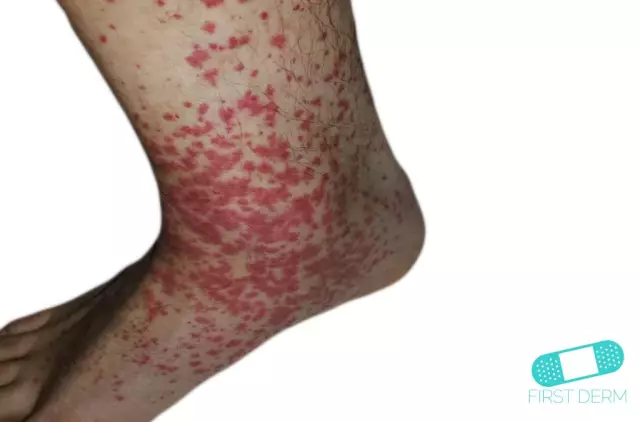- Author Curtis Blomfield [email protected].
- Public 2023-12-16 20:44.
- Last modified 2025-01-23 17:01.
Vasculitis is a disease that is associated with inflammation of the vascular walls. The causes of its occurrence can be different, the disease can affect blood vessels of various types and sizes. Therefore, vasculitis is a common name for a group of ailments related to blood vessels:
- Arteritis - inflammation of the walls of the arteries.
- Capillaritis - inflammation of the capillary walls.
- Arteriolitis - inflammation of arterioles (small arteries).
- Phlebitis - inflammation of the walls of the veins.
There is also systemic vasculitis. This is a lesion of the walls of vessels of various types.

Reasons
To understand what causes this disease, you must first understand the difference between a disease that occurs on its own (primary vasculitis) and vascular damage that is the result of another disease. Primary vasculitis is an ailment, the causes of which are not fully understood by medicine. The appearance of secondary vasculitis can be caused by the following factors:
- Various acute or chronic infections of viral and bacterial etiology.
- Genetic predisposition.
- Individual body response of some people to vaccination.
- Contact with toxic substances that are used to treat certain diseases (cancer and others).
- Exposure to the body of various chemicals.
- Severe overheating of the body.
- Long exposure to low temperatures, that is, severe hypothermia.
- Various injuries.
- Burns (including sunburn).

Any of these factors can cause disease by causing a change in the antigenic structure of blood vessel tissues. Together, their influence is increasing. The body reacts to this with rejection. He begins to consider the cells of his own vessels as foreign objects and develop antibodies to fight them. Vasculitis of the skin is caused by various allergic reactions. Segmental and localized disease occurs due to the entry of pathogens into the vascular walls. There is also hemorrhagic vasculitis. Its symptoms are quite difficult to diagnose. This is a chronic disease, the onset of which is provoked by various infections, but the inflammation of the vascular walls is aseptic in nature (without infection).

Symptoms
Patients with systemic vasculitis experience similar symptoms. The disease begins with a fever, during which the body temperature periodically rises and falls. Periods of significant increasetemperatures correspond to the appearance of new vascular inflammation. Signs of vasculitis are also bruising on the skin. In the future, hemorrhages can affect the joints, muscles and internal organs. Which organ will be affected depends on which vessels will be affected by the disease. If the disease appears on the background of arthritis, then first there are general symptoms of inflammation, and after about a month vasculitis is already manifested. When the joints are affected, joint pain and arthritis are observed. Systemic vasculitis, as a rule, is characterized by a long course with constant progression, periodic exacerbations. The prognosis of recovery depends on which organs are affected by the disease and how big changes have occurred in them.






